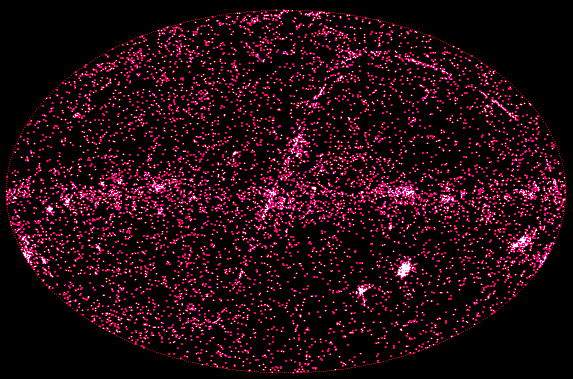Exploring The Universe With IUE (1978-1996)

Credit & Copyright:
J. Bonnell and M. Perez
(GSFC),
NASA
Explanation:
How do planets, stars, and galaxies form? How do they evolve?
The International Ultraviolet Explorer (IUE) satellite
was launched
in 1978 and operated by
NASA/
ESA/
PPARC
to help
provide answers to some of the most fundamental
questions about the contents of our universe.
IUE served as a geostationary orbiting observatory
for the next 18 years acquiring over 100,000 observations
with its onboard ultraviolet
spectrographs.
Its prodigious scientific
output is only hinted at by the all-sky plot above which shows the
locations of IUE's many pointed observations over its long
operational history.
The brightness of a point on the sky represents the
the number of IUE observations.
The plot is in galactic coordinates (the plane of our Galaxy
runs horizontally through the middle) and reveals
the positions of distant
quasars,
galaxies, stars, star clusters, nebulae, novae, and
supernovae - testifying
to IUE's broad range of capabilities.
The ecliptic plane
is also visible running diagonally
through the center, traced out by many
observations of solar system objects.
After over 18 years,
IUE's science operations
officially end today as the final commands
are transmitted to the aging satellite
by controllers at NASA's Goddard Space Flight Center.
Astronomers from around the world whose careers have been touched
by IUE have expressed their
fond farewells to this most productive and longest
lived astronomical satellite and their
thanks to all who have made
IUE's remarkable voyage of exploration
possible.
News Flash:
BATSE Detects Huge Gamma Ray Burst
Authors & editors:
Robert Nemiroff
(MTU) &
Jerry Bonnell
(USRA)
NASA Web Site Statements, Warnings,
and Disclaimers
NASA Official: Jay Norris.
Specific
rights apply.
A service of:
LHEA at
NASA /
GSFC
& Michigan Tech. U.

